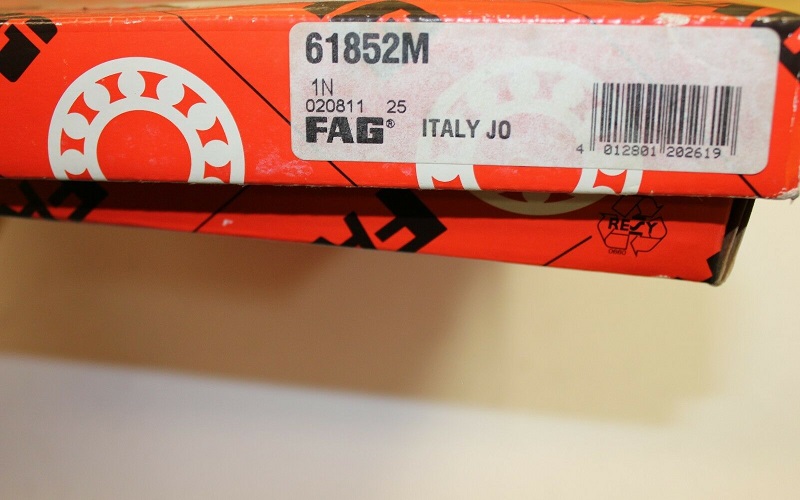
 News
NewsFor the use of bearings, noise is very common. Even low-noise bearings in FAG bearings have the same situation. So, why does noise occur? Today I will introduce its essence to you.
(1) The raceway sound of FAG bearing and its control method The raceway sound is a slippery and continuous sound produced by rolling elements on the raceway surface of the FAG bearing when the FAG bearing is running, which is unique to all rolling bearings. Basic sound. The general bearing sound is the raceway sound plus other sounds. The raceway sound of a ball bearing is irregular, the frequency is above 1000 Hz, its main frequency does not change with the speed, but its total sound pressure level increases with the speed of the speed. For bearings with loud raceway sound, the sound pressure level of the raceway sound decreases with the increase in viscosity; while for bearings with low raceway sound, the sound pressure level of the bearing with low raceway sound changes from a decrease when the viscosity increases to more than about 20mm2/s. To have increased. The greater the rigidity of the bearing seat, the lower the total sound pressure level of the raceway sound. If the radial clearance is too small, the total sound pressure level and main frequency of the raceway sound will increase sharply as the radial clearance decreases. The methods to control the raceway sound are: select low-noise bearings, that is, bearings with small waviness, and carefully choose the conditions of use. The noise of the raceway often affects the noise of the entire machine, reducing the noise of the raceway can reduce the noise of the entire machine.
(2) The impact sound of rolling elements and their control methods. When larger ball bearings or cylindrical roller bearings run at low speeds under pure radial load, because the centrifugal force of the rolling elements is small, the rolling elements in the non-load area will Impact on the cage or raceway and make noise. But as the speed increases, this sound will disappear. The methods for controlling the impact sound of rolling elements include: appropriately reducing the radial clearance, and using bearings with a reasonable structure and a flexible cage.
(3) FAG bearing rolling noise and its control method Rolling noise is the harsh metal friction sound that may occur in cylindrical roller bearings in all occasions. Most of them occur in grease-lubricated bearings of larger models, but in the base oil Deteriorated grease is more likely to occur, and it hardly occurs during oil lubrication. In addition, it is more likely to happen in winter. When bearing pure radial load, it is easy to happen in occasions with large radial clearance, and depending on the size of the model, it is easy to happen in a specific speed range, and it will happen continuously. It will appear intermittently again. The outer ring raceway adopts a special processing method to prevent the occurrence of rolling noise. If necessary, this kind of bearing can be selected, or the radial clearance of the bearing can be appropriately reduced, the use of excellent grease and the rigidity of the parts matching the bearing can be improved .
Contact us for more information about FAG Bearing 61852M.

After the FAG bearing is installed, in order to check whether the installation is correct, a running check is required. Small machines can be rotated by hand to confirm whether they rotate smoothly. The inspection items include improper operation due to foreign objects, scars, and indentations, unstable torque due to poor installation and poor processing of the mounting seat, excessive torque due to too small clearance, installation errors, and seal friction, etc. Wait. If there is no abnormality, power operation can be started.
Large-scale machinery cannot be rotated manually, so immediately cut off the power after starting without load, and the machinery is idling. Check for vibration, noise, and contact with rotating parts. After confirming that there is no abnormality, enter the power operation.
The power operation starts at a low speed with no load and slowly increases to the rated operation under the specified conditions. The items to be checked during the test run are whether there are abnormal sounds, changes in FAG bearing temperature, lubricant leakage or discoloration, etc. If an abnormality is found, stop the operation immediately, inspect the machine, and remove the bearing for inspection if necessary.
FAG bearing temperature can generally be estimated based on the external temperature of the bearing seat. However, it is more accurate to use the oil hole to directly measure the temperature of the outer ring of the bearing. The temperature of the bearing gradually increases from the start of operation, and usually stabilizes after 1 to 2 hours. If the bearing is installed improperly, the temperature will rise sharply, resulting in abnormally high temperature. The reasons include too much lubricant, too small bearing clearance, poor installation, and excessive friction of the sealing device. In the case of high-speed rotation, the wrong choice of FAG bearing structure and lubrication method is also the reason.
The rotation of the FAG bearing is checked with a stethoscope, etc., there are strong metal noises, abnormal sounds, irregular sounds, etc., indicating abnormalities. The reasons include poor lubrication, poor shaft or bearing seat accuracy, bearing damage, and foreign matter intrusion.